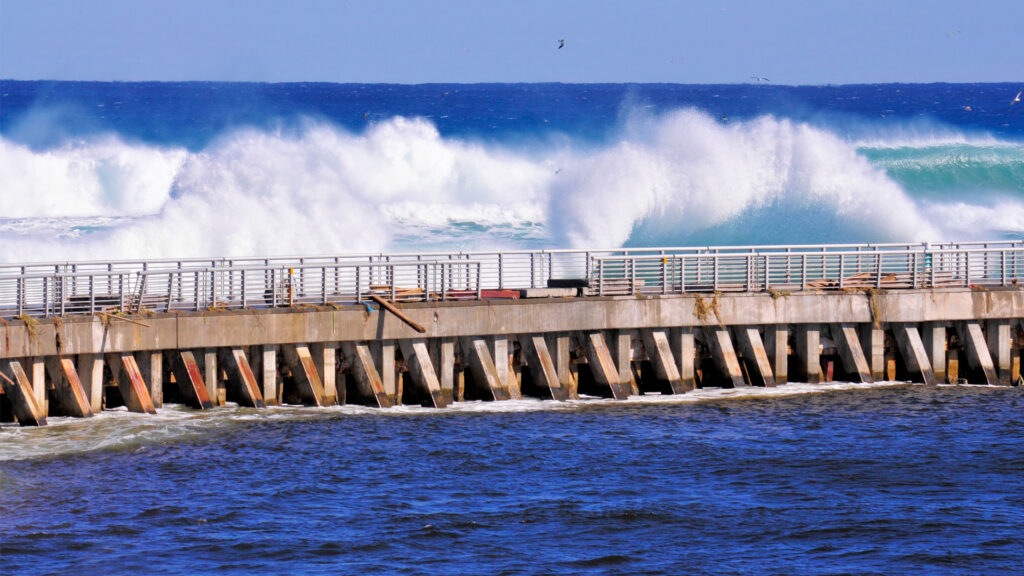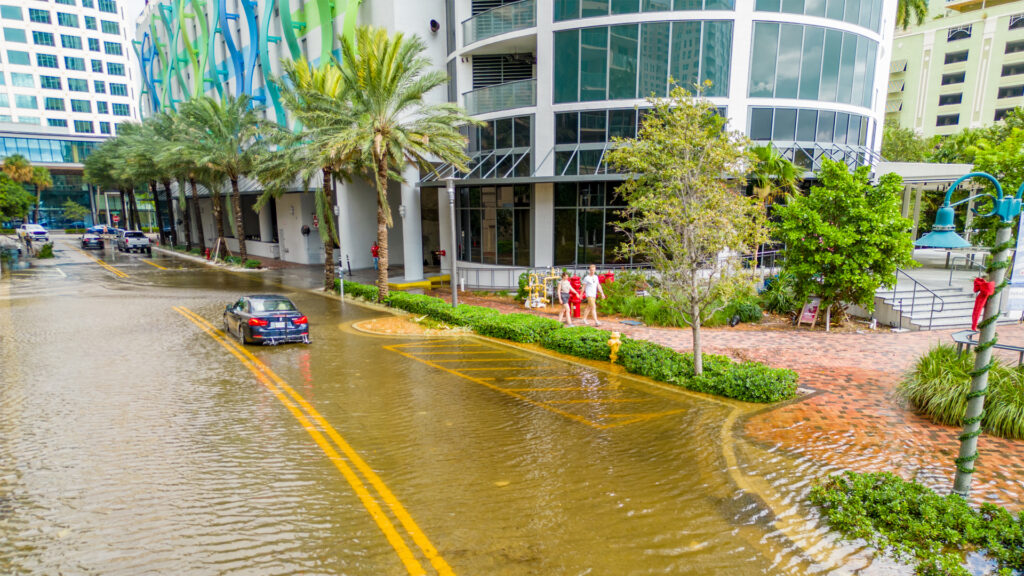By David Drucker, FIU News

Artificial intelligence is becoming an asset in hurricane forecasting.
In 2024, an AI-based model created by Google correctly predicted Hurricane Beryl would make landfall in Texas while a top traditional model called for landfall in Mexico. Two months later, another AI-based model foresaw Hurricane Francine’s landfall in Louisiana many days in advance of traditional models.
Now, there is another dimension of hurricane forecasting where AI is expected to make an impact: flood forecasting.
Coastal engineering expert Navid Tahvildari studies how AI can be used to predict floods at the College of Engineering and Computing. While few such models are public today, he says, the technology and knowledge needed to make them are quickly coming together.
Tahvildari sat down with FIU News to discuss AI’s potential in flood forecasting.
What can AI flooding models do that traditional models cannot?
AI-based models have several interesting advantages, in my opinion.
The first is speed. Once trained, AI-based models operate at much greater efficiency than traditional forecasting systems. They run in a matter of seconds, not hours. And they can operate on personal laptops, while traditional models require expensive and powerful computers. This gives AI models greater flexibility in creating forecasts.
This advantage becomes particularly pronounced when we want to make high-resolution forecasts at the scale of individual buildings. Physics-based traditional models — the industry standard for decades — take a long time to produce results at this street-level scale over a large geographical area. Meanwhile, research shows that AI models — trained by high-resolution output from traditional models—can generate reliable flood forecasts in a matter of seconds.
An additional appealing advantage of AI-based models is that they “think” differently than traditional computer models. Similar to how ChatGPT uses an abundance of information it has already learned to answer users’ questions, AI-based models use an abundance of environmental data from the past to create predictions about the future. Previous water levels, atmospheric data and even images of floods captured by cameras from many past events can be used by AI models to predict flooding. By contrast, traditional physics-based models can typically be calibrated using only a few past events.
So, will AI models replace traditional models?
No, AI models probably won’t be replacing traditional, physics-based flood models anytime soon. Rather, both types of models have compelling strengths, and combining the best of the two technologies should help us create better forecasts in the future.
Given that computing power has increased more than a thousand-fold in the last 30 years, why do traditional flooding models still take hours to run?

To understand this problem, we need to appreciate the extraordinary complexity behind hurricane flooding.
During a hurricane, storm surge and waves interact with coastal landscape and rush inland. As this water comes onshore, the terrain changes flow patterns. Even seemingly minor elements like marsh vegetation can somewhat influence wave movement and surge by creating friction. If you want an accurate flood forecast, you need to account for all these factors in one way or another.
In traditional, physics-based flood forecasting, these factors are converted into complex mathematical equations and connected to form what is essentially a giant math problem. Solve that, and you have your forecast.
These models become very expensive to run over a large area if they have to also “zoom in” and resolve things at the street level. Think about it: To predict flooding accurately at a very high level of granularity, the computer has to account for thousands of small details that affect flooding, like depressions in roadways, for example. So, traditional models take a long time to account for everything. They must compromise: They can either run street level simulations at small areas at a time, or run over low-resolution grids that miss small details but produce results faster.
How are AI flooding models able to run so much faster and with higher resolution?
AI-based models can skip over the complicated math that traditional models do by basing their predictions entirely off of past observations.
In the U.S., there is plenty of real-time data on environmental conditions right before a flood, like tides, winds, waves, and rainfall. There is also a wealth of information coming from flood sensors, the number of which has been growing rapidly in recent years.
AI can connect the dots between recorded flood data and recorded hurricane conditions to predict the details of an incoming flood.
There is a catch though: AI models are accurate only in the range of data they are trained with, so they may struggle with predicting outcomes for the most powerful, extreme hurricanes. Since these storms are rare, there is not much historic extreme data available for AI to learn from.
This is a shortcoming that can be overcome by combining physics-based models and AI models. Specifically, we can use physics-based models to generate the extreme conditions that are scarce or missing in historic records and feed that to AI models. This approach enables forecasts that will mimic the nuanced relationships that physics-based forecasts capture while retaining the speed that artificial intelligence brings.
How might this technology help South Florida in the future?

These models yield numerous practical applications for South Florida, especially from an emergency management standpoint.
One example: AI’s ability to rapidly simulate “What if?”’ flooding scenarios where multiple flood sources come together could become very important.
In coastal areas, there is a king tide – an unusually high tide – happening once per year in the fall, coinciding with the hurricane season. If a storm was threatening to make landfall in South Florida during king tide – as Major Hurricane Dorian nearly did in 2019 – the flood threat would be severe, and decision-makers would probably want to have a quickly-generated, comprehensive forecast – the kind of prediction that AI-based models excel at.
Another example that could help Floridians: In a previous study, we used a traditional physics-based flood model to find the best locations to place ambulances prior to a hurricane and determine areas that should be served aerially so that patients can be transported to critical trauma centers as soon as possible. AI can help with such decisions by enabling rapid forecasts based on the most recent information on hurricane track and intensity.
When might we see AI-based flooding models that South Floridians can use before the next storm?
I think that we are close to being able to make forecasts like these for upcoming storms, technology-wise. The ultimate goal is to have a model like this available to you on your smartphone. But first, we need more data. These AI models need to be trained with substantial amounts of it, with high resolution in space and time, to produce reliable predictions.
While more flood sensors are coming online, they are still scarce, and physics-based models need to improve to produce reliable synthetic data to train AI models. In the case of urban flooding, for example, we need models that not only capture tides and surge hydrodynamics but also simulate rainfall-driven flooding. We also need to incorporate information from other features that affect flooding, like stormwater infrastructure, tide gates, etc. Modeling efforts that bring these capabilities together have gained traction recently, but more work needs to be done.
What’s next?
What’s exciting to me is that at FIU, we have opportunities to apply AI alongside other hurricane-related research at the university to advance innovative hurricane preparedness solutions. FIU is home to the Wall of Wind, the only university-based hurricane simulator capable of generating Category 5 hurricane winds.
Being at FIU puts us at the epicenter of hurricane research, both in terms of research activity and actual location. I’m excited to see how my colleagues and I can build comprehensive, cutting-edge approaches to hurricane preparedness that give people the resources they need to protect what matters most.
This piece was originally published at https://news.fiu.edu/2025/how-ai-might-become-the-future-of-hurricane-flood-forecasting. Banner photo: Flooding caused by Hurricane Milton in Florida (iStock image).
Sign up for The Invading Sea newsletter by visiting here. To support The Invading Sea, click here to make a donation. If you are interested in submitting an opinion piece to The Invading Sea, email Editor Nathan Crabbe at nc*****@*au.edu. To learn more about king tides, watch the video below.



